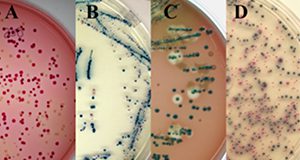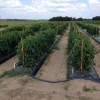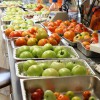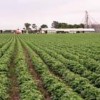
Shiga toxin is a protein found within the genome of a type of virus called a bacteriophage. These bacteriophages can integrate into the genomes of the bacterium E. Coli. Even though most E. coli are benign or even beneficial members of our gut microbial communities, strains carrying Shiga-toxin encoding genes are highly pathogenic in humans and other animals. This six-page fact sheet discusses the two types of Shiga toxins and the best approaches to identifying and determining which Shiga toxin is present. Written by William J. Zaragoza, Max Teplitski, and Clifton K. Fagerquist and published by the Department of Soil and Water Sciences.
http://edis.ifas.ufl.edu/ss654
Tag: Max Teplitski
Contribucion de las practicas de produccion de cultivos y las condiciones climaticas a la seguridad microbiologica de los tomates y pimientos
 Durante la última década, las frutas, verduras y frutos secos se encuentran entre los alimentos relacionados con brotes de gastroenteritis causadas por cepas enterovirulentas de E. coli y Salmonella no tifoidea que resultan en miles de hospitalizaciones y pérdidas de varios millones de dólares en la industria de alimentos (Mandrell 2009; Batz, Hoffman, y Morris 2011). Desde 2006, dieciséis brotes de salmonelosis se han relacionado con el consumo de frutas y verduras, incluyendo tomates, melones, coles, pepinos, mangos, piñones, pistachos, mantequilla de maní, papayas, pimientos y además alimentos congelados y procesados que contienen productos vegetales. Esta hoja informativa fue producida para proveer información actualizada sobre las prácticas de producción de tomate y sus asociaciones con Salmonella. Esta información es útil para Agentes de Extensión Agraria en sus programas de educación sobre cultivos hortícolas. This 4-page fact sheet is the Spanish language version of The Role of Crop Production Practices and Weather Conditions in Microbiological Safety of Tomatoes and Peppers (SS628). It was written by Massimiliano Marvasi, Max Teplitski, and George Hochmuth, and published by the UF Department of Soil and Water Science, February 2015.
Durante la última década, las frutas, verduras y frutos secos se encuentran entre los alimentos relacionados con brotes de gastroenteritis causadas por cepas enterovirulentas de E. coli y Salmonella no tifoidea que resultan en miles de hospitalizaciones y pérdidas de varios millones de dólares en la industria de alimentos (Mandrell 2009; Batz, Hoffman, y Morris 2011). Desde 2006, dieciséis brotes de salmonelosis se han relacionado con el consumo de frutas y verduras, incluyendo tomates, melones, coles, pepinos, mangos, piñones, pistachos, mantequilla de maní, papayas, pimientos y además alimentos congelados y procesados que contienen productos vegetales. Esta hoja informativa fue producida para proveer información actualizada sobre las prácticas de producción de tomate y sus asociaciones con Salmonella. Esta información es útil para Agentes de Extensión Agraria en sus programas de educación sobre cultivos hortícolas. This 4-page fact sheet is the Spanish language version of The Role of Crop Production Practices and Weather Conditions in Microbiological Safety of Tomatoes and Peppers (SS628). It was written by Massimiliano Marvasi, Max Teplitski, and George Hochmuth, and published by the UF Department of Soil and Water Science, February 2015.
http://edis.ifas.ufl.edu/ss630
Impacto de las variedades de tomate y su estado de madurez en la susceptibilidad a Salmonella
 De 1998 a 2007 la fruta fresca, verdura, especias y nueces fueron comúnmente asociados con brotes de gastroenteritis (Batz, Hoffman, y Morris 2011). Salmonella se ha convertido en uno de los patógenos humanos más problemáticos asociado a productos frescos, nueces y a los alimentos que contienen esos ingredientes (Batz, Hoffman, y Morris 2011; deWaal, Tian, y Plunkett 2009). Esta hoja informativa fue producida para proveer información actualizada sobre las prácticas de producción de tomate y sus asociaciones con Salmonella. Esta información es útil para los Agentes de Extensión Agraria en sus programas de educación sobre cultivos hortícolas. This 3-page fact sheet is the Spanish language version of Impact of Tomato Varieties and Maturity State on Susceptibility of Tomatoes to Salmonella (SS627). It was written by Massimiliano Marvasi, Max Teplitski, and George Hochmuth, and published by the UF Department of Soil and Water Science, February 2015. (Photo: Max Teplitski)
De 1998 a 2007 la fruta fresca, verdura, especias y nueces fueron comúnmente asociados con brotes de gastroenteritis (Batz, Hoffman, y Morris 2011). Salmonella se ha convertido en uno de los patógenos humanos más problemáticos asociado a productos frescos, nueces y a los alimentos que contienen esos ingredientes (Batz, Hoffman, y Morris 2011; deWaal, Tian, y Plunkett 2009). Esta hoja informativa fue producida para proveer información actualizada sobre las prácticas de producción de tomate y sus asociaciones con Salmonella. Esta información es útil para los Agentes de Extensión Agraria en sus programas de educación sobre cultivos hortícolas. This 3-page fact sheet is the Spanish language version of Impact of Tomato Varieties and Maturity State on Susceptibility of Tomatoes to Salmonella (SS627). It was written by Massimiliano Marvasi, Max Teplitski, and George Hochmuth, and published by the UF Department of Soil and Water Science, February 2015. (Photo: Max Teplitski)
http://edis.ifas.ufl.edu/ss629
The role of crop production practices and weather conditions in microbiological safety of tomatoes and peppers
 Salmonella and other human pathogens can contaminate produce at any stage from “farm to fork.” If we can better understand how production practices may make crops more or less susceptible to human pathogens we may be able to significantly reduce the number and severity of the produce-associated outbreaks. This 3-page fact sheet provides up-to-date information about tomato production practices and their relationships with Salmonella. Written by Massimiliano Marvasi, George Hochmuth, and Max Teplitski, and published by the UF Department of Soil and Water Science, December 2014. (Photo: Max Teplitski, UF/IFAS)
Salmonella and other human pathogens can contaminate produce at any stage from “farm to fork.” If we can better understand how production practices may make crops more or less susceptible to human pathogens we may be able to significantly reduce the number and severity of the produce-associated outbreaks. This 3-page fact sheet provides up-to-date information about tomato production practices and their relationships with Salmonella. Written by Massimiliano Marvasi, George Hochmuth, and Max Teplitski, and published by the UF Department of Soil and Water Science, December 2014. (Photo: Max Teplitski, UF/IFAS)
http://edis.ifas.ufl.edu/ss628
Impact of Tomato Varieties and Maturity State on Susceptibility of Tomatoes to Salmonella
 Non-typhoidal Salmonella has emerged as one of the problematic human pathogens associated with fresh produce, nuts, and complex foods containing them. Recent research shows that some varieties of plants are more “resistant” to colonization by the pathogens than others. This raises the intriguing possibility that cultivar selection could be used to identify crop varieties that may be less conducive to proliferation of human pathogens. This 3-page fact sheet provides up-to-date information about tomato production practices and their relationships with Salmonella. Written by Massimiliano Marvasi, George Hochmuth, and Max Teplitski, and published by the UF Department of Soil and Water Science, December 2014. (Photo: Max Teplitski, UF/IFAS)
Non-typhoidal Salmonella has emerged as one of the problematic human pathogens associated with fresh produce, nuts, and complex foods containing them. Recent research shows that some varieties of plants are more “resistant” to colonization by the pathogens than others. This raises the intriguing possibility that cultivar selection could be used to identify crop varieties that may be less conducive to proliferation of human pathogens. This 3-page fact sheet provides up-to-date information about tomato production practices and their relationships with Salmonella. Written by Massimiliano Marvasi, George Hochmuth, and Max Teplitski, and published by the UF Department of Soil and Water Science, December 2014. (Photo: Max Teplitski, UF/IFAS)
http://edis.ifas.ufl.edu/ss627
Salmonella y Escherichia coli enteropatogena en el ambiente de produccion de cultivos: fuentes potenciales, supervivencia y gestion (SL375Span/SS577)
 El objetivo de esta publicación EDIS es poner en evidencia los descubrimientos recientes que se enfocan en la ecología de los patógenos humanos en el área de producción de cultivo. Una mejor comprensión de cómo los patógenos persisten fuera de los huéspedes animales en el agua para la agricultura, en el suelo y en las plantas, tendrá grandes impactos en el manejo y procesamiento de los productos mismos, empezando desde el productor y hasta el consumidor. This 3-page fact sheet was written by Massimiliano Marvasi, Max Teplitski, Andrée George, and George Hochmuth, and published by the UF Department of Soil and Water Science, November 2012.
El objetivo de esta publicación EDIS es poner en evidencia los descubrimientos recientes que se enfocan en la ecología de los patógenos humanos en el área de producción de cultivo. Una mejor comprensión de cómo los patógenos persisten fuera de los huéspedes animales en el agua para la agricultura, en el suelo y en las plantas, tendrá grandes impactos en el manejo y procesamiento de los productos mismos, empezando desde el productor y hasta el consumidor. This 3-page fact sheet was written by Massimiliano Marvasi, Max Teplitski, Andrée George, and George Hochmuth, and published by the UF Department of Soil and Water Science, November 2012.
http://edis.ifas.ufl.edu/ss577
Salmonella and Pathogenic E. coli in the Crop Production Environment: Potential Sources, Survival, and Management (SL375/SS576)
 Over the last two decades, at least a dozen major outbreaks of gastroenteritis caused by non-typhoidal Salmonella or enterovirulent E. coli have been linked to the consumption of sprouts, nuts, and fresh (or minimally processed) fruits and vegetables. These outbreaks caught scientists and the public off guard because these pathogens were not previously considered “plant-associated.” This 3-page fact sheet highlights recent discoveries that focus on the ecology of human pathogens in the crop production environment. A better understanding of how pathogens persist outside of animal hosts in agricultural water, soils, and plants will have major impacts on managing produce safety from “farm to fork.” Written by Max Teplitski, Andree George, and George Hochmuth, and published by the UF Department of Soil and Water Science, October 2012.
Over the last two decades, at least a dozen major outbreaks of gastroenteritis caused by non-typhoidal Salmonella or enterovirulent E. coli have been linked to the consumption of sprouts, nuts, and fresh (or minimally processed) fruits and vegetables. These outbreaks caught scientists and the public off guard because these pathogens were not previously considered “plant-associated.” This 3-page fact sheet highlights recent discoveries that focus on the ecology of human pathogens in the crop production environment. A better understanding of how pathogens persist outside of animal hosts in agricultural water, soils, and plants will have major impacts on managing produce safety from “farm to fork.” Written by Max Teplitski, Andree George, and George Hochmuth, and published by the UF Department of Soil and Water Science, October 2012.
http://edis.ifas.ufl.edu/ss576
SL305/SS518 The Importance and Status of Florida Coral Reefs: Questions and Answers
SL-305, a 6-page illustrated fact sheet by Cory J. Krediet, Kim Ritchie, and Max Teplitski, addresses some questions regarding coral reef biology, coral reef health, and the ecological and economic benefits coral reefs provide. Includes references. Published by the UF Department of Soil and Water Sciences, August 2009.
http://edis.ifas.ufl.edu/SS518
SL263SP/SS486 Salmonella y tomates: preguntas y respuestas para los consumidores
SL263-SP, a 7-page fact sheet by Max Teplitski, Keith Schneider, Michelle Danyluk, and Claudio Gonzalez, is the Spanish-language version of SL263, “Salmonella and Tomatoes: Q & A for Consumers”. It provides research-supported answers to common consumer questions about the safety of fresh fruits and vegetables in response to the recent outbreak of salmonellosis linked to the consumption of tomatoes. Includes references. Published by the UF Department of Soil and Water Science, June 2008.
http://edis.ifas.ufl.edu/SS486
SL263/SS484 Salmonella and tomatoes: Q & A for consumers
SL-263, a 6-page fact sheet by Max Teplitski, Keith Schneider and Michelle Danyluk, provides research-supported answers to common consumer questions about the safety of fresh fruits and vegetables in response to the recent outbreak of salmonellosis linked to the consumption of tomatoes. Includes references. Published by the UF Department of Soil and Water Science, June 2008.
http://edis.ifas.ufl.edu/SS484
SL259/SS482 Indicator Organisms: What Every Floridian May Want to Know about Microbiological Water Quality
SL-259, a 3-page fact sheet by Max Teplitski and J. Dwain Butler, is designed to help the reader interpret the results of a microbiological water test. Includes references. Published by the UF Department of Soil and Water Sciences, March 2008.
http://edis.ifas.ufl.edu/SS482